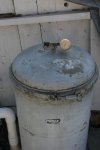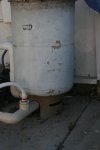Hi TFP denizens,
I've been learning in the background for over a year now and the first thing I would like to say is "Thank you to all for the wealth of info that you guys provide."
I made it thru my first year as a newbie pool owner with very little problems except one small algae bloom easily taken care of with the BBB method as found within this forum.
Now that winter is here, it is time for me to start on some ventures of equipment changing and upgrading that cannot be easily done during the swimming season.
My pool: ~1980's rectangular 24K gal. IG gunite w/ stainless steel upper panels (no tile), 1 main drain, 1 skimmer, 2 returns, 1.5 hp Hayward Superpump, Hayward side-mount sand filter, 1.5 inch plumbing.
Swimming season pool maintenance is no problem (less than 5 min./day), so, my main goal for the upcoming season is optimum energy savings with no loss in pool performance.
Following are some of the problems with my pool setup that I will be considering to fix (please correct me if I'm wrong, and add opinions, also)
1. Pump is too big and inefficient
2. All piping on the equipment pad is poorly routed and inefficient.
3. There is no label on the sand filter to indicate what size it is and know if it's the right size for my pool,(although it seems to filter just fine)
So, starting with Problem 3, How do I confirm which Hayward filter I have with no label?
Problem 2, I have decided to tear out all plumbing on the equipment pad and redo. I even dug up and removed the entire length of suction line all the way to the skimmer because first, it wasn't too big of an job, and second, it's no problem to increase sizing of suction line from skimmer to, hopefully, better help my hydraulic situation.
Questions with Problem 2 (keeping in mind that I will eventually be changing pump to probably a 2 speed in the near future)
1. Will I benefit by increasing skimmer suction line size when I cannot change main drain suction line size?
2. Where is the best place to install check valves in a typical piping system such as mine?
3. After handling all of the above, I need help in determining which pump to upgrade to as I get very confused in hydraulics, head and pump curves.
Thanks in advance for any advice given.
I've been learning in the background for over a year now and the first thing I would like to say is "Thank you to all for the wealth of info that you guys provide."
I made it thru my first year as a newbie pool owner with very little problems except one small algae bloom easily taken care of with the BBB method as found within this forum.
Now that winter is here, it is time for me to start on some ventures of equipment changing and upgrading that cannot be easily done during the swimming season.
My pool: ~1980's rectangular 24K gal. IG gunite w/ stainless steel upper panels (no tile), 1 main drain, 1 skimmer, 2 returns, 1.5 hp Hayward Superpump, Hayward side-mount sand filter, 1.5 inch plumbing.
Swimming season pool maintenance is no problem (less than 5 min./day), so, my main goal for the upcoming season is optimum energy savings with no loss in pool performance.
Following are some of the problems with my pool setup that I will be considering to fix (please correct me if I'm wrong, and add opinions, also)
1. Pump is too big and inefficient
2. All piping on the equipment pad is poorly routed and inefficient.
3. There is no label on the sand filter to indicate what size it is and know if it's the right size for my pool,(although it seems to filter just fine)
So, starting with Problem 3, How do I confirm which Hayward filter I have with no label?
Problem 2, I have decided to tear out all plumbing on the equipment pad and redo. I even dug up and removed the entire length of suction line all the way to the skimmer because first, it wasn't too big of an job, and second, it's no problem to increase sizing of suction line from skimmer to, hopefully, better help my hydraulic situation.
Questions with Problem 2 (keeping in mind that I will eventually be changing pump to probably a 2 speed in the near future)
1. Will I benefit by increasing skimmer suction line size when I cannot change main drain suction line size?
2. Where is the best place to install check valves in a typical piping system such as mine?
3. After handling all of the above, I need help in determining which pump to upgrade to as I get very confused in hydraulics, head and pump curves.
Thanks in advance for any advice given.



